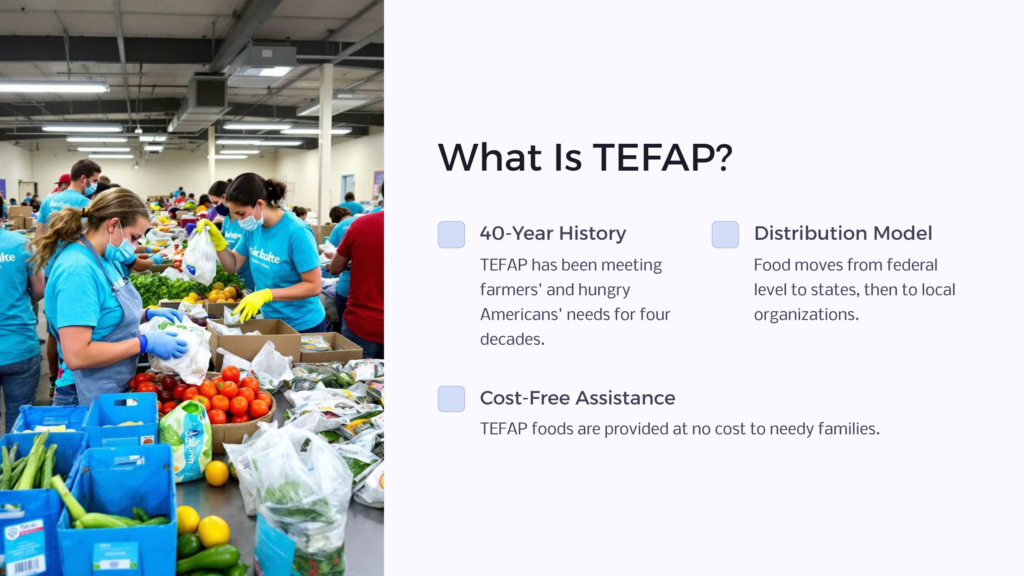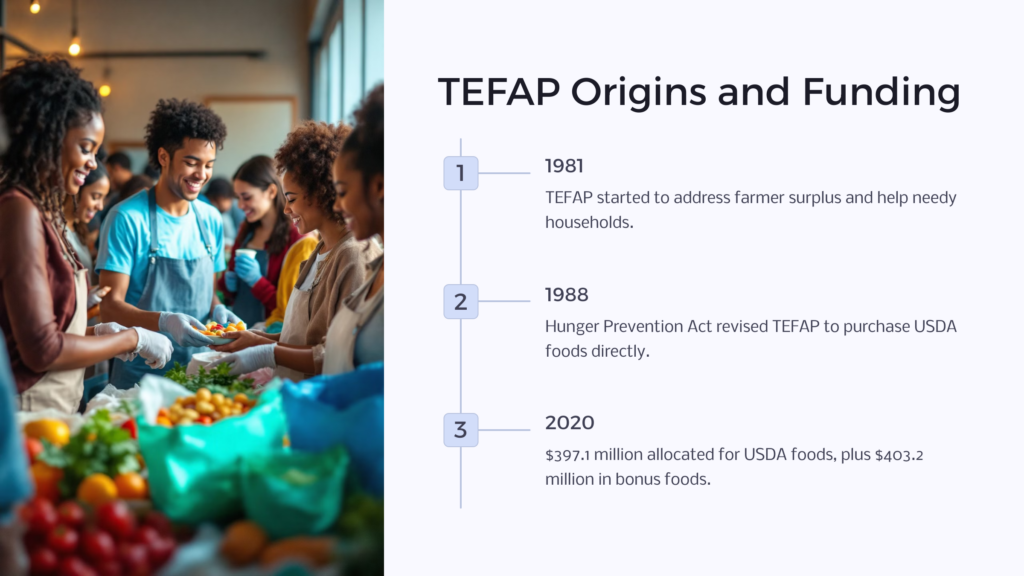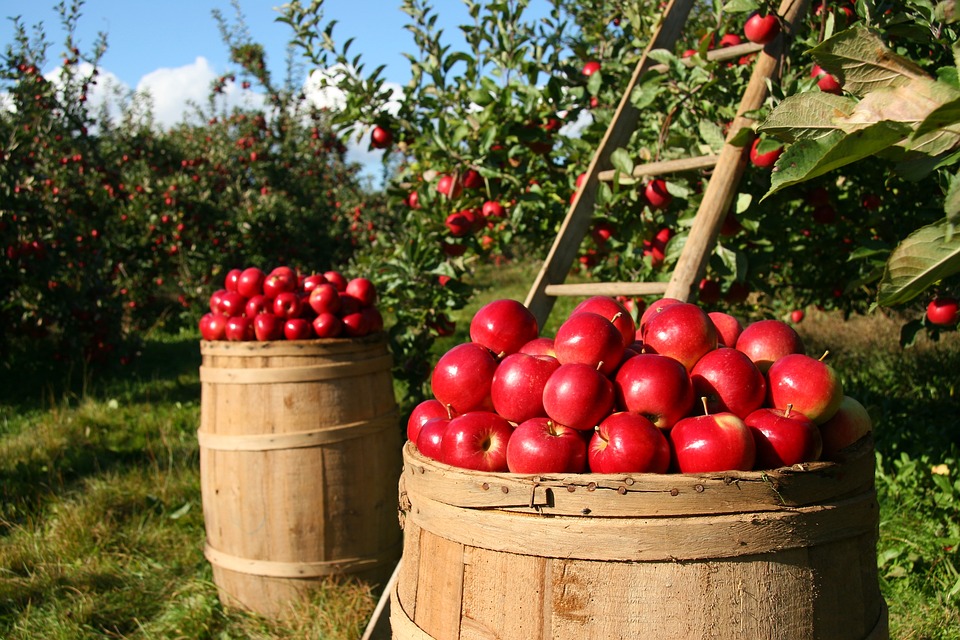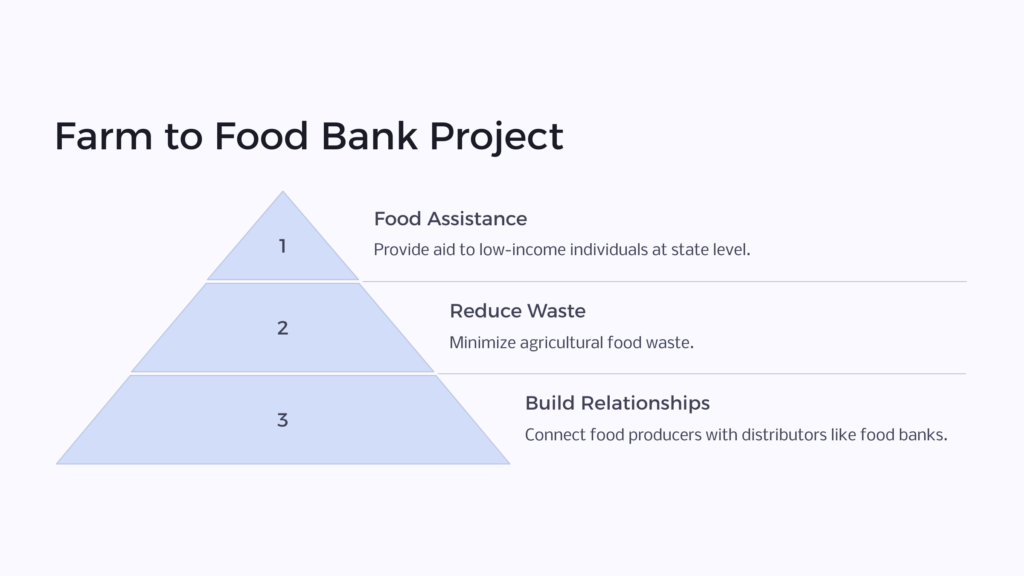The Emergency Food Assistance Program (TEFAP) is a federal aid program for low-income individuals of any age. The United States Department of Agriculture (USDA) purchases food from farmers and sends it to individual states based on the specific needs of its residents. It is determined at the state level which local organizations and agencies receive TEFAP food.
7 Common Questions About TEFAP
- What Is TEFAP?
- Who Is Eligible for TEFAP?
- How Did TEFAP Begin?
- How Is TEFAP Funded?
- What Role Do States Play In TEFAP?
- What Types of Food Does TEFAP Provide?
- What Is the Farm to Food Bank Project?
TEFAP enables federal and state agencies to work together to support USDA farmers and provide ongoing emergency food assistance to those who need it most. TEFAP is one of many food aid programs such as the Supplemental Nutrition Assistance Program (SNAP) or National School Lunch Program (NSLP) that are intended for low-income Americans of all ages who cannot afford to buy sufficient food on their own.
Though there is federal oversight of TEFAP, it’s left to the states to determine and enforce eligibility requirements. Thus, some states will have different criteria for income limits, household size, and other measures of need.
What Is TEFAP?

TEFAP stands for The Emergency Food Assistance Program. This program has been in existence for 40 years in the U.S. to meet the needs of farmers and hungry Americans. The TEFAP distribution model can respond to supply and demand in the shifting agricultural sector and provide millions of dollars in nutritional food assistance across the country.
TEFAP commodities move from the federal level down to the individual states who then pass them along to local organizations like food banks, distribution centers, community action agencies, or food pantries. All TEFAP foods are provided at no cost to needy families, and the program also provides for the administrative costs associated with packaging, employment, record-keeping, and final distribution.
Many of these food banks are aided by the help of the national organization, the Feeding America Network. This is the U.S.’s largest domestic hunger-relief organization and it has worked closely with TEFAP since the program’s inception. Each year this organization provides over a billion meals made with TEFAP foods, and over a third of the food they distribute comes from USDA food producers.
Who Is Eligible for TEFAP?
TEFAP is available to individuals of any age who meet low-income requirements. This is a federal requirement, but it’s up to the states themselves to determine what income limits they’ll use, what information they require recipients to submit, and how they’ll evaluate their applicants.
Each state has different needs and what constitutes “low income” in one state may not be true for another. To decide upon limits, states can use existing enrollment in assistance or welfare programs that use income as a basis for qualification. This could be SNAP benefits, Child and Adult Care Food Program (CACFP), Supplemental Security Income (SSI), Low-income Energy Assistance Program (LEAP), Medicaid, or any other means-tested federal program.
The low-income requirements are required for all recipients of TEFAP foods except for those receiving prepared meals. These are single meals that would be served at places like a soup kitchen. For these meals, recipients do not need to pass any means-test or prove their income to qualify for a meal.
Per federal civil rights regulations, TEFAP is an equal opportunity provider and does not discriminate based on race, color, national origin, age, sex, or disability. The only requirement for aid is that recipients meet the income requirements laid out by each state.
TEFAP also has means for those who are deaf, hard of hearing, or blind to obtain assistance by calling the USDA office at (800) 877-8339. To file a program discrimination complaint, you can fill out a complaint form (Form AD-3027) and send it into the USDA program at the following address:
U.S. Department of Agriculture
Office of the Assistant Secretary for Civil Rights
1400 Independence Avenue, SW
Washington, D.C. 20250-9410
You may also choose to email the form to program.intake@usda.gov, or fax it to (202) 690-7442.
How Did TEFAP Begin?

Originally started in 1981, TEFAP had two main goals. The first was to address a surplus in USDA foods that American farmers were producing to help them avoid food waste and severe economic impact on their livelihood. At this time in the economy, many U.S. farmers were in danger of going bankrupt or losing their farms if they could not sell off their crops in time, and TEFAP aimed to remedy that.
The second goal was to help needy households who were unable to provide enough food for themselves or their families. Though other food assistance programs existed at the time, this was the first such program of its scale that directly linked U.S. farmers to a distribution chain to the individual American.
For the first seven years of the program, it achieved both its goals, but in 1988 the surplus food inventories had been largely used up and the program shifted slightly. The Hunger Prevention Act of ‘88 allowed TEFAP to continue, but it revised the program to use funds to purchase USDA foods directly (instead of solely surplus foods) to fulfill the needs of the states.
It has since followed this model and included additional funds to purchase what’s known as “bonus” foods that farmers produce in excess and can’t sell. The amount of bonus foods varied each year depending on the market for farm commodities.
How Is TEFAP Funded?
TEFAP is a federally funded program that runs through the Food and Nutrition Service (FNS), an agency under the USDA. It gets its funding through Congress and the farm bill which is renewed every five years.
The current farm bill is the Agriculture Improvement Act of 2018 and in 2020 it allotted $397.1 million to buy USDA foods for the program and an additional $403.2 million in bonus foods. These amounts change to reflect the needs of low-income households in each state as well as the needs of farmers.
In 2021, due to the growing COVID-19 pandemic, the program was awarded an additional $400 million to be used to purchase and distribute USDA foods.
The bulk of this money is used to purchase USDA foods from farmers, but a portion of the total is earmarked for administrative funds and distribution costs. States can also choose to allocate more of their allotment for administrative costs but some of the funds must be passed down to the local level distributors.
What Role Do States Play In TEFAP?
Each state is allocated an amount of USDA emergency food based on the number of residents who are unemployed or living below the poverty level. Once the state receives the USDA food, it is up to them to decide how and where it’s distributed within the state.
Typically, states will send food packages to a larger agency such as a food bank that oversees larger regional areas. The food banks then distribute the food within their specific region to community programs, soup kitchens, homeless shelters, a food pantry, or other eligible recipient agencies (ERAs). The food can then be allotted to individuals as either unprepared food boxes or prepared meals.
What Types of Food Does TEFAP Provide?

The types of food that TEFAP buys and distributes can frequently change, depending on the agricultural needs of the farmers and the preferences of the states. For example, if there was a national surplus in a specific type of grain, the TEFAP program would buy that from producers and pass it along to the states to be used in food boxes.

Though the specific type of food may vary, they all must meet nutritional requirements that help meet the dietary guidelines set out by the U.S. Department of Agriculture. The five categories of nutritious foods are fruits, vegetables, protein foods, grains, and dairy.
Typical foods that are found in a food box from TEFAP consist of:
- Fresh, frozen, or canned vegetables and fruits
- Whole grains or enriched grain products like cereal, rice, or pasta
- Protein foods like meat, fish, eggs, or peanut butter
- Dairy products
- Other essential items like cooking oil
What Is the Farm to Food Bank Project?

The Farm to Food Bank Project was started with the Agriculture Improvement Act of 2018 that amended the original TEFAP legislation.
This new program still provides food to low-income individuals through local food banks, but instead of the federal government buying food from producers, it provides funds for farmers to donate surplus unharvested foods that would otherwise go to waste.
The bill states the funds may be used for the “harvesting, processing, packaging, or transportation of unharvested, unprocessed, or unpackaged commodities donated by agricultural producers, processors, or distributors for use by emergency feeding organizations (EFOs).”
Importantly, these new funds can’t be used to cover existing TEFAP operations, and can’t actually pay the farmers for the food itself. The funds only provide the means for them to harvest and distribute it.
The Farm to Food Bank Project has three main goals:
- Provide food assistance to low-income individuals at the state level
- Reduce agricultural food waste
- Forge relationships with food producers and distributors like food banks
Unlike TEFAP, this program is not entirely federally funded. No more than 50% of the needed funds for each state can come from federal sources, leaving the remaining 50% to be matched by the state. This can be done through private donations or state funds.
In 2020, there was $3.75 million in available funds to states who chose to participate in the Farm to Food Bank Project. For states to be eligible for this additional funding they must have submitted a state plan amendment describing in detail how they will implement the Farm to Food Bank Project in their region.
The Emergency Food Assistance Program
TEFAP provides essential nutrition for millions of Americans who are food insecure. This federal program helps ensure that each state can help its most needy residents by providing healthy food that’s grown and produced by American farmers.
This successful program not only helps those who are hungry, but also the farmers who grow and distribute the food. It also allows the federal government to respond to the needs and fluctuations of the agricultural sector while local organizations can make decisions about what works best for their specific regional needs.
To find out more about your state’s TEFAP food assistance programs or eligibility requirements, contact your local State Distributing Agency.
 Benefits.com Advisors
Benefits.com Advisors
With expertise spanning local, state, and federal benefit programs, our team is dedicated to guiding individuals towards the perfect program tailored to their unique circumstances.
Rise to the top with Peak Benefits!
Join our Peak Benefits Newsletter for the latest news, resources, and offers on all things government benefits.




















